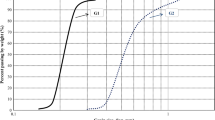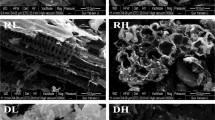Abstract
A laboratory analysis is presented in this study that evaluates the impact of three different biochars, derived from biowastes of sludge (SDB), manure (MDB) and spent coffee grounds (SCGDB), on the physical properties of a loamy sand soil. Column experiments are conducted to measure the hydraulic conductivity and water content of these biochars when mixed with soil at a fixed concentration (5% with respect to (w.r.t) reference soil) under saturated conditions. The results show a substantial increase of the hydraulic conductivity for the biochars derived from SCGDB and SDB, whereas no changes were observed for MDB. The saturated water content is increased with the addition of SCGDB and trivial changes are observed for the remaining treatments. Numerical computations using HYDRUS-1D are conducted for a hypothetical scenario, revealing the different impact that each biochar has on the reference soil.







Similar content being viewed by others
References
Lehmann J, Joseph S (2009) Biochar for environmental management: science and technology. Earthscan, London
Major J, Lehmann J, Rondon M, Goodale C (2010) Fate of soil-applied black carbon: downward migration, leaching and soil respiration. Glob Change Biol 16:1366–1379. https://doi.org/10.1111/j.1365-2486.2009.02044.x
Downi A, Crosky A, Munroe P (2009) Physical properties of biochar. In: Biochar for environmental management: science and technology. Earthscan, London, pp 13–29
Ouyang L, Wang F, Tang J, Yu L, Zhang R (2013) Effects of biochar amendment on soil aggregates and hydraulic properties. J Soil Sci Plant Nut 13(4):991–1002. https://doi.org/10.4067/S0718-95162013005000078
Wong JTF, Chen ZK, Ng CWW, Wong MH (2016) Gas permeability of biochar amended clay: potential alternative landfill cover material. Environ Sci Pollut Res 23:7126–7131. https://doi.org/10.1007/s11356-015-4871-2
Basso AS, Miguez FE, Laird DA, Horton R, Westgate M (2013) Assessing potential of biochar for increasing water-holding capacity of sandy soils. GCB Bioenergy 5:132–143. https://doi.org/10.1111/gcbb.12026
Ulyett J, Sakrabani R, Kibblewhite M, Hann M (2014) Impact of biochar addition on water retention, nitrification and carbon dioxide evolution from two sandy loam soils. Eur J Soil Sci 65:96–104. https://doi.org/10.1111/ejss.12081
Dugan E, Verhoef A, Robinson S, Sohi S, Gilkes R, Prakpongkep N (2010) Biochar from sawdust, maize stover and charcoal: Impact on water holding capacities (WHC) of three soils from ghana. In: Proceedings of the 19th World Congress of Soil Science, Brisbane, Australia 1–6 August
Karhu K, Mattila T, Bergstrom I, Regina K (2011) Biochar addition to agricultural soil increased CH4 uptake and water holding capacity-Results from a short-term pilot field study. Agric Ecosyst Environ 140:309–313. https://doi.org/10.1016/j.agee.2010.12.005
Asai H, Samson BK, Stephan HM, Songyikhangsuthor K, Homma K, Kiyono Y, Inoue Y, Shiraiwa T, Horie T (2009) Biochar amendment techniques for upland rice production in N,orthern Laos 1. Soil physical properties, leaf SPAD and grain yield. Field Crop Res 111:81–84. https://doi.org/10.1016/j.fcr.2008.10.008
Ayodele A, Oguntunde P, Joseph A, Souza Dias Junior M (2009) Numerical analysis of the impact of charcoal production on soil hydrological behavior, runoff response and erosion susceptibility. Rev Bras Cienc Solo 33:137–145
Stylianou M, Christou A, Dalias P, Polycarpou C, Michael P, Agapiou A, Papanastasiou P, Fatta-Kassinos D (2020) Physicochemical and structural characterization of biochar derived from the pyrolysis of biosolids, cattle manure and spent coffee grounds. J Energy Inst 93(5):2063–2073. https://doi.org/10.1016/j.joei.2020.05.002
Jeffery S, Meinders MB, Stoof CR, Bezemer TM, van de Voorde TFJ, Mommer L, van Groenigen W (2015) J. Biochar application does not improve the soil hydrological function of a sandy soil. Geoderma 251-252:47–54. https://doi.org/10.1016/j.geoderma.2015.03.022
Hardie M, Clothier B, Bound S, Oliver G, Close D (2014) Does biochar influence soil physical properties and soil water availability? Plant Soil 376:347–361. https://doi.org/10.1007/s11104-013-1980-x
Major J, Rondon M, Molina D, Riha SJ, Lehmann J (2012) Nutrient leaching in a Colombian savanna oxisol amended with biochar. J Environ Qual 41(4):1076–1086. https://doi.org/10.2134/jeq2011.0128
Brewer CE, Chuang VJ, Masiello CA, Gonnermann H, Gao X, Dugan B, Driver LE, Panzacchi P, Zygourakis K, Davies CA (2014) New approaches to measuring biochar density and porosity. Biomass Bioenergy 66:176–185. https://doi.org/10.1016/j.biombioe.2014.03.059
Lehmann J., da Silva JP Jr, Rondon MCM, Greenwood J, Nehls T, Steiner C, Glaser B (2002) Slash-and-char—a feasible alternative for soil fertility management in the Central Amazon. In: 17th world congress of soil science, Bangkok
Jeffery S, Bezemer TM, Cornelissen G, Kuyper TW, Lehmann J, Mommer L, Sohi SP, van de Voorde TFJ, Wardle DA, Van Groenigen JW (2013) The way forward in biochar research: targeting trade-offs between the potential wins. Glob Chang Biol Bioenergy 7(1):1–13. https://doi.org/10.1111/gcbb.12132
Simunek J, van Genuchten M. T. h., Sejna M (2008) Development and applications of the HYDRUS and STANMOD software packages and related codes. Vadose Zone J 7(2):587–600. https://doi.org/10.2136/vzj2007.0077
Simunek J, Sejna M, Saito H, Sakai MT, van Genuchten M (2009) The HYDRUS-1D software package for simulating the movement of water, heat, and multiple solutes in variably saturated media. Version 4.08. HYDRUS. Software Series 3 p. 330, Department of Environmental Sciences. University of California, Riverside. USA
Horel A, Toth E, Gelybo G, Dencso M, Farkas C (2019) Biochar amendment affects soil water and CO2 regime during capsicum annuum plant growth. Agronomy 9:58. https://doi.org/10.3390/agronomy9020058
Wu Y, Yang A, Zhao Y, Liu Z (2019) Simulation of soil water movement under biochar application based on the Hydrus-1D in the black soil region of China. Appl Ecol Env Res 17(2):4183–4192. https://doi.org/10.15666/aeer/1702_41834192
Lim TJ, Spokas KA, Feyereisen G, Novak JM (2016) Predicting the impact of biochar additions on soil hydraulic properties. Chemosphere 142:136–144. https://doi.org/10.1016/j.chemosphere.2015.06.069
Tan KH (1995) Soil sampling, preparation, and Analysis. Books in soils, plants, and the environment. Taylor & Francis, New York
Thien SJ, Graveel J (2002) Laboratory manual for soil science: agricultural & environmental principles. McGraw-Hill, New York
Masuda H, Higashitani K, Yoshida H (2006) Powder technology handbook. CRC Press, Boca Raton
Stylianou M, Lee JH, Kostarelos K, Voskaridou T (2018) Laboratory testing in support of surfactant-alternating-gas foam flood for napl recovery from shallow subsurface. B Environ Contam Tox 101:744–750. https://doi.org/10.1007/s00128-018-2453-y
Van Genuchten MT (1980) A closed-form equation for predicting the hydraulic conductivity of unsaturated soils. Soil Sci 44:892–898. https://doi.org/10.2136/sssaj1980.03615995004400050002x
Mualem YA (1976) A new model for predicting the hydraulic conductivity of unsaturated porous media. Water Resour Res 12:513–521. https://doi.org/10.1029/WR012i003p00513
Database of fully developed channel flow. Internal report, AURA station, Environ mental Fluid Mechanics lab (EFM Lab), CEE, UCY, 2019
Gamie R, Smedt F (2017) Experimental and statistical study of saturated hydraulic conductivity and relations with other soil properties of a desert soil. Eur J Soil Sci 69(2):256–264. https://doi.org/10.1111/ejss.12519
Funding
Support from the Republic of Cyprus through the Research Promotion Foundation Project P2P/WATER/1017/0007, and from the internal research programs of the University of Cyprus.
Author information
Authors and Affiliations
Corresponding author
Additional information
Publisher’s Note
Springer Nature remains neutral with regard to jurisdictional claims in published maps and institutional affiliations.
Rights and permissions
About this article
Cite this article
Stylianou, M., Panagiotou, C.F., Andreou, E. et al. Assessing the influence of biochars on the hydraulic properties of a loamy sand soil. Biomass Conv. Bioref. 11, 315–323 (2021). https://doi.org/10.1007/s13399-020-01114-0
Received:
Revised:
Accepted:
Published:
Issue Date:
DOI: https://doi.org/10.1007/s13399-020-01114-0




